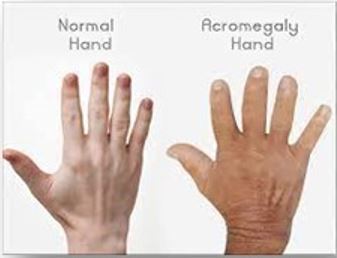Managing Acromegaly : Case Discussion on Surgery and Medications
M3 India Newsdesk Jun 16, 2023
The article covers the diagnostic process (OGTT, GH and IGF-1 levels, MRI) and management options for acromegaly, emphasising trans-sphenoidal surgery as the primary treatment and the use of somatostatin analogues and other medications when needed.
Case presentation
The case
A 50-year-old woman presents to the clinic with complaints of arthralgia, increased sweating and persistent headache for 2 months. She has also noticed a change in the size of her ring size.
She has a past medical history of Type 2 DM and hypertension.
On examination,
- Her facial features are coarse.
- She has a palpable goitre along with macroglossia.
- The systemic examination is unremarkable.
- Her blood pressure and random blood sugars were within normal range.
Diagnosis
-
Diagnosis of acromegaly was suspected in her case on the basis of her signs and symptoms links:
- Arthralgia
- Increased sweating
- Headaches
- The size of her ring size
All the above signs point towards a diagnosis of acromegaly and establishing the same OGTT and IGF-1 levels should be done.
- To establish GH levels, a mean of several GH should be done.
- Other pituitary hormones were investigated as this patient has a palpable goitre, although this could be caused by overstimulation of follicular cells by high levels of GH and IGF-1 resulting in non-toxic multinodular goitre (Dabrowska et al).
- The patient goes under further testing with the following results:
- IGF1: raised x 2 folds
- OGTT: GH levels > 1 ng/mL
- Prolactin: 360 mIU/L. (<250)
- FT4: 22.3 IU/L. (9-19)
- TSH: <0.01 mIU/L (0.4-4.5)
- Short synacthen test: normal
- MRI PITUITARY: 17 mm pituitary adenoma, not compressing optic chiasma
This patient's signs, symptoms and lab reports were suggestive of acromegaly with goitre caused by hyperthyroidism.
- MRI was suggestive of macroadenoma without any compression of the optic chiasma. The increased prolactin levels are most probably because of the stalk effect caused by the adenoma. The adenoma can explain the decreased release of TSH.
Management
- This patient underwent trans-sphenoidal surgery.
- Post-surgery she was able to attain the GH< 2.5mcg/l.
- This patient failed to go under complete remission for which she was started on somatostatin analogues after which she was able to achieve complete remission.
Discussion
Acromegaly is caused by the overproduction of GH/IGF-1 most often associated with anterior pituitary adenoma. It is known as pituitary gigantism if occurs in children prior to puberty;
- Most characteristics feature is associated with a change in facial features, hand and feet.
- Excess GH affects almost every organ system and it also manifests metabolic consequences like increased insulin resistance, diabetes mellitus, hypercalciuria and hypercalcemia.
- In a minority of the cases, there is co-secretion of prolactin which could present as a feature commonly seen in hyperprolactinemia.
The clinical feature which will raise suspicion are:
- Acral enlargement: Increased hand, shoe and ring size. Frontal bossing with the prominent supraorbital ridge
- Skin: Increased sweating with increased sebaceous activity
- Musculoskeletal: Arthropathy, prognathism, dental malocclusion
- Alimentary: Macroglossia, colonic polyps, visceromegaly
- Reproductive: Impotence, Amenorrhoea, Prostatic hypertrophy
- Respiratory: sleep apnoea
- Neurological: headache, carpal tunnel syndrome
- Effect of tumour: visual filed defects and hypopituitarism

Comparison of hand in acromegaly

Clinical features seen in acromegaly patients
Investigation
- It consists of an oral glucose tolerance test, random GH, IGF-1 levels, MRI, pituitary function testing, and growth hormone day curve.
- The oral glucose tolerance test (OGTT) remains the gold standard test for diagnosing acromegaly.
- Post 75g oral glucose load failure of suppression in GH < 0.33 mcg/l is suggestive of acromegaly, the normal response is Gh suppression to undetectable levels.
Differential diagnosis of raised GH
Pain, puberty, pregnancy, stress, chronic renal failure, chronic liver failure, heart failure, Diabetes mellitus, malnutrition, prolonged fasting, severe illness, and heroin addiction.
Management
The management strategy depends on the individual patients and the tumour size. The treatment target is to reduce GH in all situations. The cure is defined as random GH< 1 mcg/l or nadir GH< 0.4 mcg/l on GTT.
- Transsphenoidal surgery usually remains the first-line treatment.
- Radiotherapy is usually reserved for patients following unsuccessful surgery.
- The role of medical therapy comes into play when surgery fails to induce complete remission or as primary treatment in patients where the tumour does not cause the mass effect.
- Medical therapy is initiated to reduce GH and IGF-1. The first drug of choice is somatostatin, followed by dopamine agonist (cabergoline, bromocriptine) and lastly, pegvisomant (GH receptor antagonists) should be added. Pegviosomant drug is added in the end when the patient's response to somatostatin analogues and dopamine agonists is not adequate. It can be used as monotherapy or along with octreotide if good tumour shrinkage is required. If all this fails, then radiotherapy should be considered.
Disclaimer- The views and opinions expressed in this article are those of the author and do not necessarily reflect the official policy or position of M3 India.
About the author of this article: Dr Hitesh Saraogi is a diabetologist, physician and an obesity specialist at Dhanvantari Hospital, Raj Nagar Extension, Ghaziabad.
-
Exclusive Write-ups & Webinars by KOLs
-
Daily Quiz by specialty
-
Paid Market Research Surveys
-
Case discussions, News & Journals' summaries